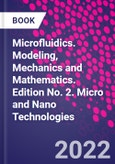Microfluidics: Modeling, Mechanics and Mathematics, Second Edition provides a practical, lab-based approach to nano- and microfluidics, including a wealth of practical techniques, protocols and experiments ready to be put into practice in both research and industrial settings. This practical approach is ideally suited to researchers and R&D staff in industry. Additionally, the interdisciplinary approach to the science of nano- and microfluidics enables readers from a range of different academic disciplines to broaden their understanding. Alongside traditional fluid/transport topics, the book contains a wealth of coverage of materials and manufacturing techniques, chemical modification/surface functionalization, biochemical analysis, and the biosensors involved.
This fully updated new edition also includes new sections on viscous flows and centrifugal microfluidics, expanding the types of platforms covered to include centrifugal, capillary and electro kinetic platforms.
Please Note: This is an On Demand product, delivery may take up to 11 working days after payment has been received.
Table of Contents
Part I: Fundamentals1. Introduction
2. Introduction to Maple
3. Engineering Mathematics
4. Series
5. Transforms
6. Thermodynamics
7. Vector Calculus
8. Differential Equations
Part II: Bulk Fluid Flows
9. Fluids
10. Conservation of Mass: The Continuity Equation
11. Conservation of Momentum: The Navier-Stokes Equation
12. Conservation of Energy: The Energy Equation and the Thermodynamic Equation of State
13. Continuity and Navier-Stokes Equations in Different Coordinate Systems
14. The Circular Flow Tube
15. Analytical Solutions to the Navier-Stokes Equation
16. Analytical Solutions to Poiseuille Flow Problems in Different Geometries
17. Hydraulic Resistance
18. Analytical Solutions to Transient Flow Problems
19. Taylor-Aris Dispersion
Part III: Fluid Surface Effects
20. Surface Tension
21. Capillarity
22. Measuring Surface Tension and Free Surface Energy
23. Plateau-Rayleigh Instability
24. The Shape of Drops
Part IV: Numerics
25. Numerical Methods for Linear Systems of Equations
26. Numerical Solutions to Nonlinear Systems: Newton's Method
27. Numerical Methods for Solving Differential Equations
28. Numerical Solutions to the Navier-Stokes Equation
29. Computational Fluid Dynamics
30. Finite Difference Method
31. Finite Volume Method
32. Finite Element Method
33. Numerical Solutions to Transient Flow Problems
34. Numerical Solutions to Three-Dimensional Flow Problems
Authors
Bastian E. Rapp Head of Group, Institute of Microstructure Technology (IMT), Karlsruhe Institute of Technology (KIT), Karlsruhe, Germany. Prof. Dr.-Ing. Bastian E. Rapp is a full professor of process technology at the Department of Microsystems Engineering (IMTEK) and the head of the NeptunLab, University of Freiburg, Germany. For his work, he was awarded, among others, the Edison Prize of the General Electric (GE) Foundation, the GMM award, and the S�dwestmetall-F�rderpreis. In 2019, he received an ERC Consolidator Grant from the European Research Council for his work on tactile displays for the visually impaired. His work has been published in the most important international journals, including Advanced Materials, Angewandte Chemie, Nature, and Science, and has been featured in national and international radio and print media, including the BBC, The New York Times, and the Discovery Channel. In 2021, he was nominated by the German Minister of Research and Education, Anja Karliczek, for the German Future Award of the German President for Technology and Innovation. In 2022, he was nominated for the German Future Award of the German President for Technology and Innovation with his spin-off company Glassomerfor the development of a new generation of techniques for high-resolution structuring of glass. His research focuses on the development of novel materials, processes, and applications in microsystem engineering, life sciences, and biotechnology, as well as instrumental and clinical analytics.







